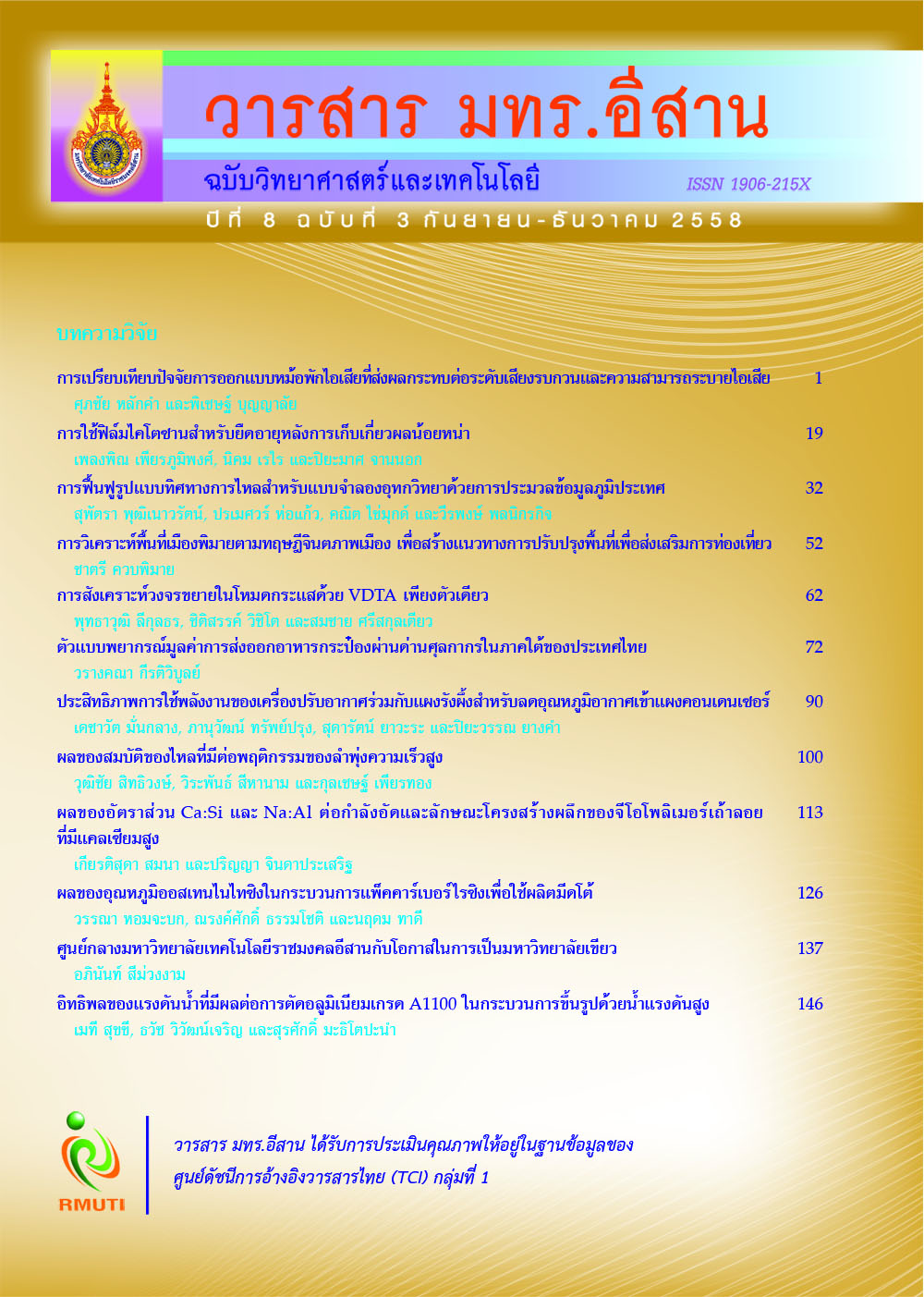ประสิทธิภาพการใช้พลังงานของเครื่องปรับอากาศร่วมกับแผงรังผึ้งสำหรับ ลดอุณหภูมิอากาศเข้าแผงคอนเดนเซอร์ Efficiency of the Energy using of Air Condition and Cooling Pad for Reducing of inlet Air Temperature of Condenser
Main Article Content
Abstract
บทคัดย่อ
การวิจัยนี้มีวัตถุประสงค์เพื่อศึกษาและทดลองการทำงานของแผงรังผึ้งและเครื่องปรับอากาศ ผลวิจัย
กรณีไม่เปิดนํ้าผ่านแผงรังผึ้งอุณหภูมิอากาศเข้าและออกจากแผงรังผึ้งเท่ากับ 34.76 ± 0.38 และ
32.82 ± 1.01 องศาเซลเซียส ความเร็วลมเท่ากับ 1.39 ± 0.01 และ 1.75 ± 0.08 เมตร/วินาที และ
ความชื้นเท่ากับ 40.00 ± 0.07 และ 41.80 ± 0.83 เปอร์เซ็นต์ และกรณีเปิดนํ้าผ่านแผงรังผึ้งอุณหภูมิ
อากาศเข้าและออกจากแผงรังผึ้งเท่ากับ 36.26 ± 0.38 และ 34.30 ± 0.23 องศาเซลเซียส
ความเร็วลมเท่ากับ 0.90 ± 0.05 และ 0.92 ± 0.01 เมตร/วินาที และความชื้นเท่ากับ 56.80 ± 1.10
และ 58.40 ± 0.55 เปอร์เซ็นต์ อุณหภูมิผิวท่อขณะไม่เปิดนํ้าและเปิดนํ้าผ่านแผงรังผึ้งบริเวณทางออก
คอมเพรสเซอร์เท่ากับ 87.5 และ 73.75 องศาเซลเซียส และบริเวณก่อนเข้าคอนเดนเซอร์เท่ากับ 74.10
และ 66.58 องศาเซลเซียส และเพื่อทดสอบประสิทธิภาพและประเมินความคุ้มค่าทางเศรษฐศาสตร์ของ
ระบบ Cooling Pad เพื่อลดอุณหภูมิอากาศเข้าแผงคอนเดนเซอร์ของเครื่องปรับอากาศพบว่า
ประสิทธิภาพในการทำงานของเครื่องปรับอากาศเท่ากับ 94.66 เปอร์เซ็นต์ สมรรถนะทางความเย็น
ขณะเปิดเครื่องปรับอากาศแต่ไม่เปิดนํ้าผ่านแผงรังผึ้งและเปิดนํ้าผ่านแผงรังผึ้งเท่ากับ 6.58 และ 11.38
ประสิทธิภาพพลังงานขณะเปิดเครื่องปรับอากาศแต่ไม่เปิดนํ้าและเปิดนํ้าผ่านแผงรังผึ้งเท่ากับ 3.41 และ
11.14 บีทียู/ชั่วโมง/วัตต์ การถ่ายเทความร้อนโดยการพาแบบบังคับขณะไม่เปิดนํ้าและเปิดนํ้าผ่านแผงรังผึ้ง
เท่ากับ 6.35 และ 9.51 วัตต์ ค่าเพาเวอร์แฟคเตอร์มิเตอร์เท่ากับ 9.16 ความคุ้มค่าทางเศรษฐศาสตร์พบว่าการติดตั้งระบบ Cooling Pad มีปริมาณพลังงานขณะเปิดเครื่องปรับอากาศให้ทำงาน แต่ไม่เปิดนํ้าผ่านแผงรังผึ้งเท่ากับ 76.56 หน่วยต่อวัน และเปิดนํ้าผ่านแผงรังผึ้งให้ทำงานร่วมกันเท่ากับ 64 หน่วยต่อวัน ปริมาณพลังงานลดลง 16.41 เปอร์เซ็นต์ ค่าไฟฟ้าขณะเปิดเครื่องปรับอากาศแต่ไม่เปิดนํ้าผ่านแผงรังผึ้งเท่ากับ 200.09 บาทต่อวัน และเปิดนํ้าผ่านแผงรังผึ้งเท่ากับ 167.27 บาทต่อวัน ค่าไฟฟ้าลดลง 16.40 เปอร์เซ็นต์
Abstract
The objectives of this research were to study and test the operation of cooling pad and
air condition system. The results found that elevated ear before Cooling Pad panels
and Cooling Pad panels were not open water through the panels were 34.76 ± 0.38 and
32.82 ± 1.01oC. The wind speed were 1.39 ± 0.01 and 1.75 ± 0.08 m/s and moisture were
40.00 ± 0.07 and 41.80 ± 0.83 percent. Temperature before Cooling Pad panels and
Cooling Pad panels when opening water through the panels were 36.26 ± 0.38 and
34.30 ± 0.23oC. Wind speed were 0.90 ± 0.05 and 0.92 ± 0.01 m/s and the humidity
were 56.80 ± 1.10 and 58.40 ± 0.55 percent. Pipe surface temperatures, while opening
water and opening water through the exit panels Cooling Pad were 87.5 and 73.75oC,
The area before the condenser were 74.1 and 66.58oC. To test the performance and
assess the economic worth of Cooling Pad to reduce the air temperature of the air
conditioning condenser panel, we found that the performance of the air conditioner
was 94.66 percent. Performance of the evening as the air conditioning, but not opening
water through the honeycomb panels and opening water through Cooling Pad panels
were equal to 6.58 and 11.38, energy efficiency, while the air conditioner, but not
turning on the water and opening water through honeycomb panels were 3.41 and
11.14 BTU/h/W, respectively. Heat transfer by convection and forced opening water
and open water through Cooling Pad panels were 6.35 and 9.51 W, with the power
factor meter were equal to 9.16 the value of economics. In addition we found that
the installation of Cooling Pad amount of energy as the air conditioning works, but not
opening water through Cooling Pad panels were 75.56 units/day, and opening water
through Cooling Pad panels, working together were 64 Units/day, energy intake
decreased by 16.41 percent of the fire as the air conditioning. However, opening water
through the Cooling Pad panel were 200.09 Baht/day and opening water through the
Cooling Pad panel were 167.27 Baht/day for electricity decreased by 16.40 percent.
Article Details
References
Napadol Mandajitra. (2553). The study to improve the efficiency of thermal power
plants. Include case studies. Access (25 July 2014). Available (http//www.erc.or.th)
Nattavoot Ruboon. (2555). Research to reduce the temperature of the air conditioning
large. Engineering Programs. Rajamangala University of Technology Isan.
Khonkaen campus
Sopon Shinsuwan. (2552). To reduce the temperature of the air before condensing unit
of the air-conditioned using heat pipes vibrating loop. Access (27 July 2014).
Available (http//www.en.kku.ac.th)
Surapon Plukpanichaja. (2529). The cycle of conditioning. Access (25 August 2014).
Available (http//www.research.eng.ku.ac.th)
Wachara Mangvitithgoon. (2544). Conditioning system diagrams. Processes and
techniques to safe-energy costs for buildings and industrial facilities. Energy
Conservation Center of Thailand. Bangkok
Weerapan Doungtongsook and Pitoon Chivongsa. (2552). Performance comparison of
cir-conditioned modular the condenser cooling with water vapor. Engineering
of the University Southeast Asia 5th. No. 1. pp. 1-10


